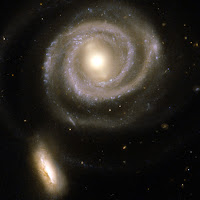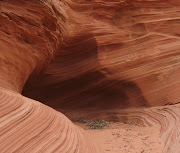When galaxies wandering through the universe collide, a spectacular display unfolds. The galaxies' stars are too spread out to actually hit each other. But the galaxies pull strongly on one another via gravity, distorting their shapes and ripping stars and gas clouds off each other to form so-called tidal tails.
The violent activity triggers huge bursts of star formation that can churn out new stars 100 times faster than in an undisturbed galaxy like our own Milky Way. This accelerated star birth is followed a few million years later by cosmic fireworks as the heavier, faster-burning stars run out of fuel and explode as supernovae. Eventually, the colliding galaxies merge to form a new, more massive galaxy.
Scientists are interested in the way these events transform galaxies and the black holes in their centres. Some believe these events are key to understanding the origin of the universe's biggest black holes, monsters weighing in at billions of times the Sun's mass.
To better understand these events, scientists led by Aaron Evans of the University of Virginia in Charlottesville, US, have trained the Hubble Space Telescope on several dozen spots in the sky where they appear underway, producing a spectacular gallery of these violent but beautiful occurrences.
 One of Hubble's troubles is that there are 1oo billion galaxies roaming the Universe under the rules of their own gravitational masses and black hole centers. The good news is ongoing renovations to the universe continue as space expands, creating more star chambers of traffic in a cooler atmosphere making galaxy collisions less likely to cause layoffs of clusters in hostile merger and acquisition star takeovers. Officer Hubble Space Telescope will be unable to catch and report on all of the DUI stars and their friends, hyperspeed super spinning teen galaxies, lenticular lane changers and those spiral galaxies mucking up the slow lane making many stars off-road into black hole event horizons ditches. Adult supervision in catching the names and classifying hundreds of millions of future galactic offenders reside at the Galaxy Zoo. A study of cluster street gangs of sheets and filaments is up for grabs.
One of Hubble's troubles is that there are 1oo billion galaxies roaming the Universe under the rules of their own gravitational masses and black hole centers. The good news is ongoing renovations to the universe continue as space expands, creating more star chambers of traffic in a cooler atmosphere making galaxy collisions less likely to cause layoffs of clusters in hostile merger and acquisition star takeovers. Officer Hubble Space Telescope will be unable to catch and report on all of the DUI stars and their friends, hyperspeed super spinning teen galaxies, lenticular lane changers and those spiral galaxies mucking up the slow lane making many stars off-road into black hole event horizons ditches. Adult supervision in catching the names and classifying hundreds of millions of future galactic offenders reside at the Galaxy Zoo. A study of cluster street gangs of sheets and filaments is up for grabs.For all the drama, however, creatures living on a planet in a colliding galaxy would experience few effects other than a very interesting night sky. TheHubble Space Telescope is now a frisky 18 years old. Just like with regular earth kids, concerned parents,galaxies' individual stars are too far apart to collide (or even disrupt each others' planetary systems, by and large). And though a pass through a brilliant star-forming region might give your upper atmosphere some high-energy heebie-jeebies, such events can't be too bad, or we couldn't have evolved here on Earth. Our Milky Way contains many identifiable star streams that are the last traces of small galaxies that collided with and merged into ours in relatively recent cosmic times.
 NASA and the European Space Agency, discovered Hubble could not see the space chalkboard of dwarfs, clouds or the awesome special effects of dark matter. Space optometrists vaulted into space in 1993, to fit Hubble with the first pair of glasses to correct myopia. Hubble's scholastic career chalked up only four visits from intergalactic interdisciplinary spacewalking teams. The next visit is from Space principals for HST to graduate in August 2008. In a fit of pique after parents said Hubble would be cut off from future funds, a Prom eclipse spawned the James Webb Stellar Telescope which will only see in infrared. American and European science sycophant taxpayers are picking up the full cost of launching JWST. Hubble is slated to complete his/her master's thesis on the Hubble Deep Space Field in 2013.
NASA and the European Space Agency, discovered Hubble could not see the space chalkboard of dwarfs, clouds or the awesome special effects of dark matter. Space optometrists vaulted into space in 1993, to fit Hubble with the first pair of glasses to correct myopia. Hubble's scholastic career chalked up only four visits from intergalactic interdisciplinary spacewalking teams. The next visit is from Space principals for HST to graduate in August 2008. In a fit of pique after parents said Hubble would be cut off from future funds, a Prom eclipse spawned the James Webb Stellar Telescope which will only see in infrared. American and European science sycophant taxpayers are picking up the full cost of launching JWST. Hubble is slated to complete his/her master's thesis on the Hubble Deep Space Field in 2013.
Some of the evidence Hubble collected spying across the Universe is in this wonderful collection of images and explanation from a trio of authors; Robin Kerrod, Carole Stott and David S. Leckrone. Illustrated with awe inspiring images enhanced for this revised edition are in the book for us intrigued universalists, Hubble: The Mirror on the Universe.















No comments:
Post a Comment